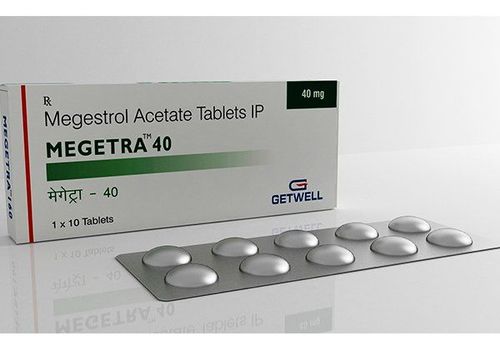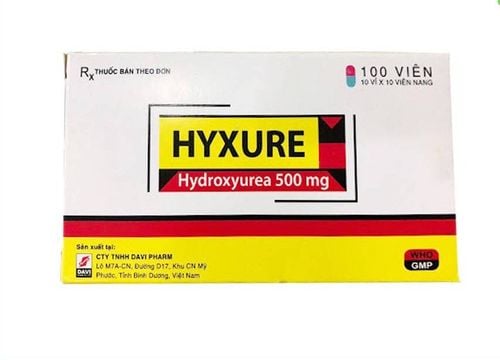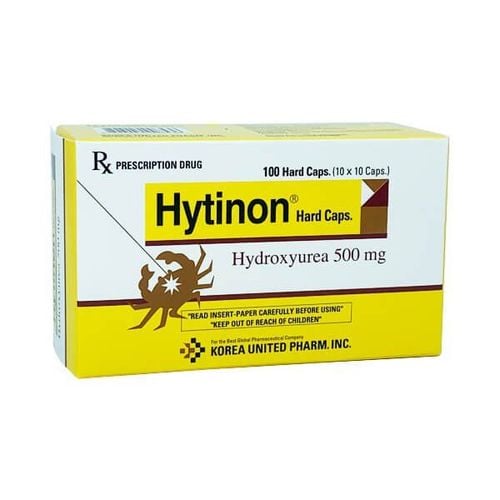This is an automatically translated article.
Hydroxyurea is a urea derivative that was first used in medicine to treat cancer. Hydroxyurea is also the main active ingredient present in Hytinon 500 medicine manufactured by Korea United Pharm. Inc.
1. What is Hytinon 500mg?
Hytinon 500 is a drug manufactured by Korea United Pharm Inc (Korea) with the main ingredient Hydroxyurea 500mg.
Hydroxyurea inhibits DNA synthesis but does not affect RNA or protein synthesis because hydroxyurea only inhibits the incorporation of Thymidine into DNA. In addition, this active substance also directly damages DNA, Hydroxyurea specifically inhibits in the S phase of the cell cycle, stops the progression of the border between G1 and S phases, thereby inhibiting DNA synthesis. The cytotoxic effect of the active ingredient Hydroxyurea is limited to tissues with a high proliferation rate, the drug has the most pronounced effect in cells that are strongly synthesizing DNA.
Hydroxyurea can also stimulate production and increase the concentration of fetal hemoglobin (Hb F), the drug has the potential to reduce sickle cell disease. However, the drug does not cure sickle cell anemia and has no role in the treatment of ongoing pain, the drug only acts to prevent pain. Hydroxyurea is also shown to be effective in supporting the treatment of idiopathic erythrocytosis because the drug inhibits bone marrow, thereby reducing the overproduction of platelets and red blood cells.
2. Uses of Hytinon 500
Hytinon 500 is indicated for use in the following cases:
Treatment of chronic myeloid leukemia; Hytinon 500 is used in combination with radiation therapy to treat cervical cancer. Hytinon 500 is contraindicated in the following cases:
Hypersensitivity to Hydroxyurea or any component of Hytinon 500; Leukopenia, thrombocytopenia (<100 x 109/l), severe anemia.
3. Dosage and usage of Hytinon 500
Hytinon 500 is an oral medication. If the patient cannot swallow Hytinon 500 tablets, the powder in the capsule can be mixed in a glass of water and taken immediately. Do not inhale or allow Hytinon 500 powder to come into contact with mucous membranes or skin.
Dosage of Hytinon 500 for adults: Can be applied on a continuous or intermittent basis, whereby the continuous regimen is more suitable for chronic myeloid leukemia, the intermittent regimen is effective. The reduced effect on the bone marrow should give a good response in the control of cervical cancer.
Take Hytinon 500 7 days before starting concurrent radiation therapy. If Hytinon 500 is given concurrently with radiation therapy, no dose adjustment of radiation therapy is usually necessary.
The time to evaluate the anti-cancer activity of Hytinon 500 is about 6 weeks, if the patient has a good clinical response, treatment with Hytinon 500 can be continued for a long time, but full follow-up is necessary to prevent cancer. No unusual or severe reactions.
Treatment of Hytinon 500 continuously with Hydroxyurea dose of 20 - 30mg/kg, taking 1 dose per day, between actual weight or ideal weight of the patient, whichever is lower and treatment should be monitored. by repeating blood count tests; Intermittent therapy: Hytinon 500 at a dose of 80mg/kg, administered as a dose every 3 days, this regimen has less risk of leukopenia, but if leukopenia persists, one or more should be omitted. More doses of Hytinon 500 . Special population Children: The disease is rare in children, so there is no treatment regimen with Hytinon 500 for this population.
Elderly: subjects who may be more sensitive to the effects of Hytinon 500 may require a lower dose.
Impaired renal function: Part of the drug Hytinon 500 is eliminated by the kidneys, consider reducing the dose in these subjects.
Acute mucosal toxicity has been reported in patients receiving Hytinon 500 at doses several times the recommended dose with symptoms of pain, erythema, edema of the palms/feet, desquamation. hand/foot skin, severe hyperpigmentation has also been reported.
Treatment of an overdose of Hytinon 500 immediately includes gastric lavage, cardiopulmonary support if required and monitoring of the hematopoietic system, if necessary the patient should receive a blood transfusion.
4. Side effects of Hytinon 500
When using Hytinon 500, patients may experience common undesirable effects such as: bone marrow depression, CD4 cell reduction, leukopenia / thrombocytopenia, decreased platelet count, anemia, anorexia, inflammation pancreatitis, nausea/vomiting, diarrhea, gastritis, constipation, mucositis,... Hytinon 500 also causes difficulty urinating, increased blood creatinine, increased blood urea, increased blood uric acid, fever, asthenia , chills, fatigue, azoospermia, polyspermia, Skin cancer, hallucinations, disorientation,...
When experiencing side effects of Hytinon 500, stop using it and notify your doctor. or go to the nearest medical facility for timely treatment.
5. Be careful when using Hytinon 500
Check bone marrow function, liver and kidney function before and during treatment with Hytinon 500; Hydroxyurea can cause bone marrow suppression, starting with leukopenia, whereas thrombocytopenia and anemia are less common and rarely occur without pre-existing leukopenia; Severe anemia must be treated before starting treatment with Hytinon 500. If anemia occurs during treatment, treatment of anemia should be carried out without discontinuing treatment with Hytinon 500. RBC abnormalities and megaloblastic anemia are limited and often occur at the beginning of treatment with hydroxyurea. Hytinon 500 also slows plasma iron clearance, reduces fetal iron absorption rate but does not change the survival time of red blood cells; In some patients on long-term treatment with Hytinon 500 for myeloproliferative disorders such as erythrocytosis, secondary leukemias have been reported, and skin cancers have also been reported in patients treated with Hytinon 500. long-term hydroxyurea treatment, so it is recommended that patients protect their skin from the sun, self-examine their skin and should be screened for secondary cancers during regular visits; Skin vascular toxicity of Hytinon 500, including ulceration and vascular necrosis, has occurred in patients with myeloproliferative disorders; Immunization with live vaccines in patients receiving Hytinon 500 may lead to serious infections, impaired antibody response to vaccines, and live vaccines should be avoided during treatment and for at least 6 months after finishing treatment with Hytinon 500 . Hytinon 500 may cause drowsiness, patients taking Hytinon 500 should not drive or operate machinery; Hytinon 500 should not be used by women who are pregnant or suspected of being pregnant, unless the physician has weighed the benefits of taking Hytinon 500 to outweigh the possible dangers; Because of the potential for serious adverse effects of Hytinon 500 in the infant, mothers should decide whether to discontinue nursing or to discontinue Hytinon 500.
6. Drug interactions of Hytinon 500
Fatal pancreatitis has occurred in HIV-infected patients treated with Hytinon 500 and Didanosin, with or without Stavudin. Hepatotoxicity and fatal liver failure have been reported after HIV treatment with Hytinon 500 and other Retroviral inhibitors. Fatal hepatic events have been frequently reported in patients receiving the combination of hydroxyurea, didanosine, and stavudine, so this combination should be avoided. Peripheral neuritis has been reported in HIV patients receiving Hytinon 500 in combination with antiretroviral agents. Hydroxyurea affects the results of analyzes of enzymes (urease, uricase, and lactic dehydrogenase) used to quantify urea, uric acid, and lactic acid, giving rise to false positives in the results of these tests in patients receiving the drug. Hytinon 500 . Thus, the above article has helped readers answer questions about the use of Hytinon 500 as well as notes for safe use of the drug.
Please dial HOTLINE for more information or register for an appointment HERE. Download MyVinmec app to make appointments faster and to manage your bookings easily.













